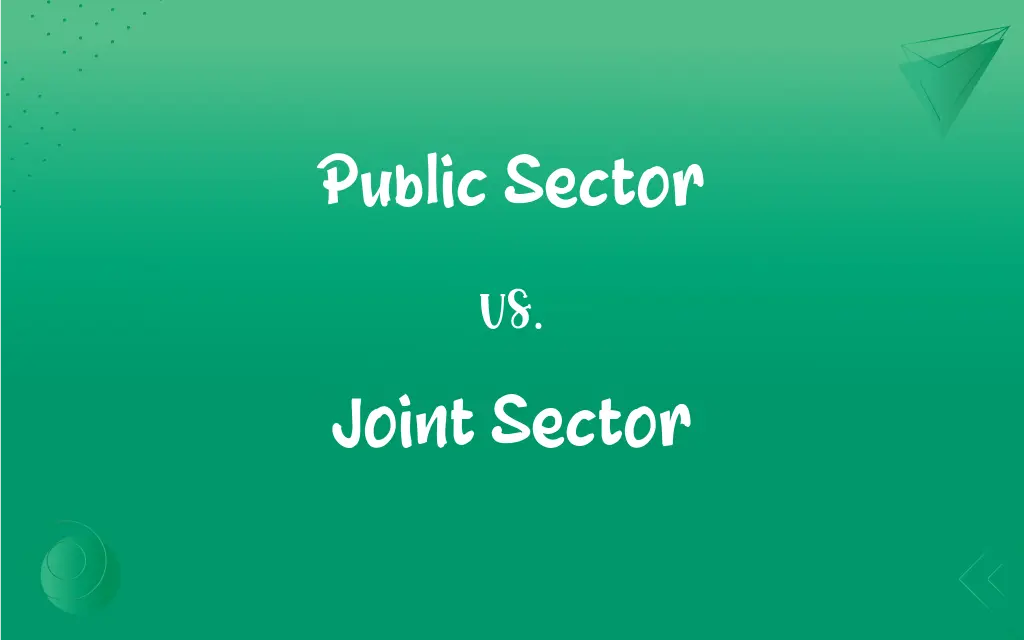Public Sector vs. Joint Sector: What's the Difference?
Edited by Aimie Carlson || By Janet White || Published on February 18, 2024
The Public Sector is wholly owned by the government, focusing on public services and welfare, while the Joint Sector involves government partnership with private entities for business ventures.

Key Differences
The Public Sector comprises entities fully controlled by the government, focusing on public welfare and essential services. In contrast, the Joint Sector represents a collaborative approach between the government and private sector, combining public objectives with private enterprise efficiency.
Public Sector organizations are funded and operated by the government, prioritizing social objectives over profitability. Joint Sector entities, however, balance public welfare goals with the profit-driven motives of private partners.
In terms of governance, the Public Sector is subject to direct governmental control and oversight, ensuring alignment with national policies. The Joint Sector, meanwhile, operates with a mix of government and private sector management practices, allowing more operational flexibility.
The Public Sector typically involves sectors like healthcare, education, and utilities, crucial for societal welfare. The Joint Sector often focuses on industries where both public interest and commercial viability converge, like infrastructure and energy.
Financially, the Public Sector relies heavily on government funding and budget allocations. In the Joint Sector, funding is a combination of government investment and private capital, potentially increasing efficiency and innovation.
ADVERTISEMENT
Comparison Chart
Ownership
Fully owned by the government
Partnership between government and private
Primary Objective
Public welfare and services
Balance of public welfare and profitability
Governance and Control
Direct government control
Mixed control (government and private)
Typical Areas of Operation
Healthcare, education, utilities
Infrastructure, energy, technology
Funding Source
Government budget
Combination of government and private capital
ADVERTISEMENT
Public Sector and Joint Sector Definitions
Public Sector
In the Public Sector, employees are often government employees.
Teachers in Public Sector schools are usually government employees.
Joint Sector
In the Joint Sector, management practices blend public and private approaches.
Management in the Joint Sector brings together the best of both worlds.
Public Sector
Public Sector entities focus on providing essential public services.
Public Sector hospitals provide healthcare to the community.
Joint Sector
Funding in the Joint Sector comes from both government and private investors.
The Joint Sector project is funded through a mix of government grants and private investment.
Public Sector
The Public Sector consists of government-operated and funded organizations.
The postal service is a part of the Public Sector.
Joint Sector
The Joint Sector involves partnerships between the government and private companies.
This new infrastructure project is a Joint Sector initiative.
Public Sector
The Public Sector is not driven by profit motives.
Public Sector schools prioritize education over making profits.
Joint Sector
Joint Sector entities combine public welfare goals with business efficiency.
Joint Sector companies can be more efficient than traditional public enterprises.
Public Sector
The Public Sector includes utilities like water and electricity.
Public Sector companies often manage the city's electricity supply.
Joint Sector
The Joint Sector is often involved in large-scale infrastructure projects.
Many airports are developed as Joint Sector ventures.
Public Sector
Alternative spelling of public sector
FAQs
What is the Public Sector?
The Public Sector consists of government-owned and operated organizations focusing on public services.
Can Public Sector organizations be profitable?
While not their primary goal, some Public Sector organizations can be profitable.
What defines the Joint Sector?
The Joint Sector is characterized by a partnership between the government and private entities for business ventures.
How is the Public Sector funded?
The Public Sector is primarily funded by government budgets and taxpayer money.
What types of services does the Public Sector provide?
The Public Sector provides essential services like healthcare, education, and utilities.
What industries are common in the Joint Sector?
Common industries in the Joint Sector include infrastructure, energy, and telecommunications.
Are Joint Sector companies always partly owned by the government?
Yes, in the Joint Sector, the government typically holds a significant ownership stake.
What is the main goal of the Joint Sector?
The Joint Sector aims to combine public welfare objectives with the efficiency of private enterprise.
Is employment in the Public Sector considered government employment?
Yes, employment in the Public Sector is typically considered government employment.
Do Joint Sector companies have more operational freedom than Public Sector entities?
Generally, Joint Sector companies have more operational freedom due to private sector involvement.
What governance challenges exist in the Joint Sector?
The Joint Sector faces challenges in balancing government regulations with private sector practices.
What is the role of the Public Sector in emergencies?
The Public Sector plays a critical role in managing and responding to emergencies and disasters.
What is the impact of the Public Sector on the economy?
The Public Sector plays a crucial role in stabilizing and supporting the economy through essential services.
How does the Public Sector affect social welfare?
The Public Sector significantly contributes to social welfare through services like healthcare and education.
Are Joint Sector projects common in developing countries?
Yes, Joint Sector projects are common in developing countries, often for large-scale development projects.
What are the benefits of a Joint Sector approach?
The Joint Sector approach benefits from government support while leveraging private sector efficiency and expertise.
How do Joint Sector ventures impact innovation?
Joint Sector ventures can drive innovation by combining government support with private sector dynamism.
Can Public Sector entities be privatized?
Yes, Public Sector entities can be privatized, transferring ownership to private hands.
Do Public Sector entities compete with private companies?
In some areas, Public Sector entities do compete with private companies, but their primary focus is service provision.
How does private sector expertise benefit the Joint Sector?
Private sector expertise brings efficiency and innovation to Joint Sector ventures.
About Author
Written by
Janet WhiteJanet White has been an esteemed writer and blogger for Difference Wiki. Holding a Master's degree in Science and Medical Journalism from the prestigious Boston University, she has consistently demonstrated her expertise and passion for her field. When she's not immersed in her work, Janet relishes her time exercising, delving into a good book, and cherishing moments with friends and family.
Edited by
Aimie CarlsonAimie Carlson, holding a master's degree in English literature, is a fervent English language enthusiast. She lends her writing talents to Difference Wiki, a prominent website that specializes in comparisons, offering readers insightful analyses that both captivate and inform.







































































